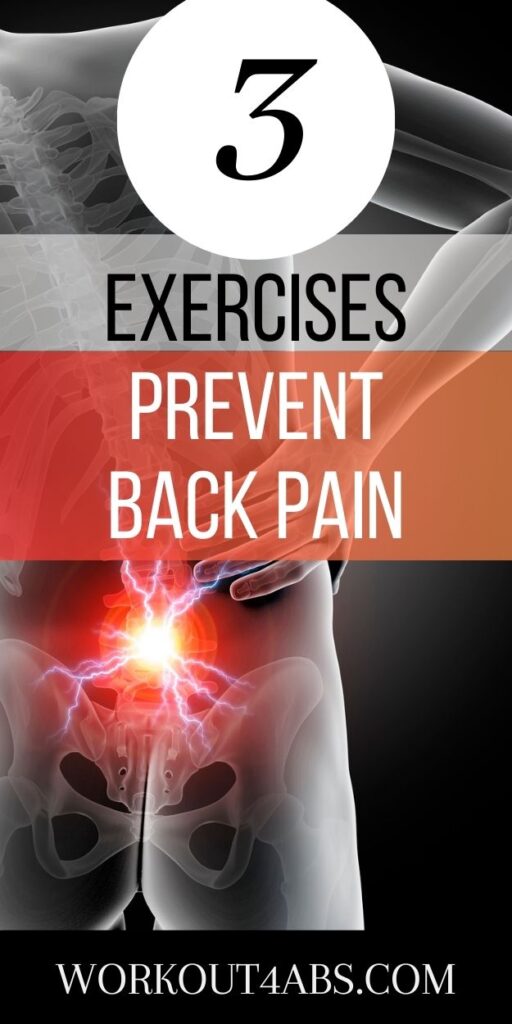Are you looking for ab exercises for back pain? Finding the right ab exercises to strengthen your core without exacerbating back pain can be a challenge. In this article, we delve into the world of ab workouts, uncovering the best choices for maintaining spinal health and identifying exercises that could potentially contribute to discomfort or injury.
If you enjoyed these tips, please save this pin to your Pinterest Board.

Core Exercise to Prevent Back Pain
Strengthening the core muscles can play a significant role in preventing back pain. The core muscles consist of the muscles in your abdomen, lower back, pelvis, and hips. Here’s how a strong core contributes to back pain prevention:
- Spinal Stability: The core muscles act as stabilizers for your spine. They help maintain proper alignment and provide support for the vertebrae, reducing the risk of straining the back muscles or injuring the spine.
- Posture Improvement: Strong core muscles help you maintain good posture, which is crucial for spinal health. Proper posture reduces the strain on the spine and surrounding muscles, minimizing the risk of developing imbalances that can lead to back pain.
- Load Distribution: A strong core distributes the load evenly across the spine and the muscles surrounding it. When lifting objects or performing physical activities, the core helps absorb and distribute the force, reducing the risk of placing excessive stress on any one area.
- Stress on the Lower Back: Weak core muscles can lead to an increased workload on the lower back muscles. This can lead to muscle imbalances, fatigue, and eventually contribute to lower back pain.
- Improved Body Mechanics: Engaging the core muscles properly during movements and activities helps promote proper body mechanics. This ensures that you’re using the correct muscles and movement patterns, reducing the risk of straining the back muscles.
- Enhanced Spinal Support: The core muscles provide a natural girdle of support for your spine. When these muscles are strong, they create a protective shield for your back, reducing the likelihood of injury.
- Functional Movement: A strong core enhances your ability to perform daily activities and functional movements with greater ease. This reduces the risk of overcompensating with other muscle groups, which can lead to strain and pain.
- Flexibility and Range of Motion: While core strength is crucial, flexibility and balanced range of motion are also important. A balanced combination of strength and flexibility ensures that the muscles around the spine can move effectively without causing discomfort.
To effectively strengthen your core and prevent back pain:
- Incorporate exercises that target various core muscles, including abdominal muscles (rectus abdominis, transverse abdominis), obliques, and lower back muscles.
- Focus on exercises that challenge your core stability, such as planks, bird dogs, bridges, and stability ball exercises.
- Combine core exercises with a balanced overall fitness routine that includes cardiovascular exercise, strength training, and flexibility work.
- Practice proper lifting techniques, engaging your core when lifting heavy objects.
- Maintain good posture throughout your daily activities, whether sitting, standing, or moving.
Remember that a comprehensive approach to back pain prevention involves overall fitness, healthy lifestyle habits, and, if necessary, consultation with healthcare professionals for personalized guidance and recommendations.
If you enjoyed these tips, please save this pin to your Pinterest Board.

Avoid Sit-ups
The traditional sit-up exercise involves lying on your back, bending your knees, and lifting your upper body off the ground by engaging your abdominal muscles. While this exercise is often used to target the abdominal muscles, it can potentially put pressure on the lower back and lead to low back pain for several reasons:
- Excessive Lumbar Flexion: During a sit-up, the movement typically involves rounding the lower back (lumbar spine) as you lift your upper body off the ground. This excessive flexion can place stress on the intervertebral discs, ligaments, and muscles of the lower back.
- Strain on Intervertebral Discs: The intervertebral discs between the vertebrae act as shock absorbers and provide flexibility to the spine. Excessive lumbar flexion in a sit-up can compress the front of the discs and potentially lead to bulging or herniation, especially when combined with repetitive or improper form.
- Stress on the Spinal Ligaments: The ligaments that support the spine can also be strained during a sit-up with improper form. The excessive flexion places tension on these ligaments, which can lead to discomfort or pain.
- Imbalanced Muscle Activation: If the hip flexors (muscles that lift the thighs towards the chest) are overly engaged during a sit-up, they can pull on the pelvis and create an anterior pelvic tilt. This posture increases the arch in the lower back, further exacerbating stress on the lumbar spine.
- Weakness of Supporting Muscles: If the muscles that support the spine, such as the deep core muscles and erector spinae (lower back muscles), are weak or not properly engaged during the movement, the spine is less stable and more prone to stress and strain.
To Perform Sit-Ups More Safely:
- Modify the Range of Motion: Instead of lifting the entire upper body off the ground, focus on lifting just the shoulder blades a few inches. This reduces the degree of lumbar flexion.
- Engage Core Muscles: Prioritize engaging your deep core muscles (transverse abdominis) and avoid pulling with your neck or using your hip flexors excessively.
- Support the Neck: Avoid tucking your chin into your chest, which can strain the neck. Instead, keep your neck neutral or gently support it with your hands.
- Incorporate Alternatives: Consider exercises that target the core without excessive lumbar flexion, such as planks, dead bugs, or leg raises.
- Seek Professional Guidance: If you experience low back pain during or after sit-ups, consult a fitness professional or physical therapist. They can assess your form and provide exercises that are safer for your spine.
Remember that maintaining proper form and prioritizing the health and safety of your spine is crucial during any exercise. If you have a history of low back pain or any pre-existing conditions, it’s advisable to consult a healthcare professional before incorporating sit-ups or any other exercises into your routine.
Planks Instead of Sit-ups
The plank exercise is often considered a better alternative to the traditional sit-up for several reasons, particularly when it comes to core strength, stability, and spinal health. Here’s why the plank is a preferred choice:
- Core Activation without Spinal Flexion: The plank focuses on engaging the core muscles, including the deep stabilizing muscles of the abdomen, without requiring excessive spinal flexion. This minimizes the risk of putting pressure on the lower back and intervertebral discs, reducing the likelihood of low back pain.
- Spinal Alignment: In a proper plank position, your spine is in a neutral alignment, which helps maintain the natural curvature of your back. This reduces the risk of straining the lower back muscles and ligaments, as there’s no excessive rounding or arching of the spine.
- Strengthening Core Stabilizers: Planks engage a wide range of core muscles, including the rectus abdominis, transverse abdominis, obliques, and even the muscles along the back (erector spinae). These muscles work together to stabilize the spine and pelvis, promoting overall core strength.
- Low Impact: Planks are a low-impact exercise, which means they don’t put excessive stress on your joints. This makes them a safer option for individuals with joint issues or those seeking an effective core exercise with reduced risk of injury.
- Variability and Progression: Planks can be modified to suit different fitness levels. Beginners can start with forearm planks, while those seeking a challenge can progress to high planks, side planks, or dynamic variations like plank leg lifts. This allows for continuous improvement and adaptation.
- Functional Core Strength: Planks simulate the isometric contraction of the core muscles that is often required in everyday activities and sports. Having a strong core helps with stability, balance, and overall functional movement.
- Time Efficiency: Planks are effective in a short amount of time. Holding a plank for as little as 30 seconds to a minute can provide substantial benefits for core strength and stability.
- Reduced Risk of Neck Strain: Unlike sit-ups, planks don’t involve neck flexion, which can strain the neck muscles and lead to discomfort or pain.
To Perform Planks Safely:
- Maintain Proper Alignment: Keep your body in a straight line from head to heels. Avoid sagging your hips or raising your hips too high.
- Engage the Core: Focus on pulling your belly button toward your spine to engage the deep core muscles.
- Support the Neck: Keep your neck in line with your spine by looking at the floor a few inches in front of you.
- Breathe: Don’t hold your breath. Inhale and exhale naturally as you hold the plank.
Remember that form is crucial in any exercise to prevent injury and achieve the desired results. If you have any existing health conditions or concerns, consider consulting a fitness professional or healthcare provider before incorporating planks or any other exercises into your routine.
If you enjoyed these tips, please save this pin to your Pinterest Board.

Avoid Russian Twists
Russian Twist and Low Back Pain: The Russian Twist is an exercise that involves sitting on the ground, leaning back slightly, and twisting the torso from side to side while holding a weight or medicine ball. While this exercise can target the oblique muscles, it can potentially lead to low back pain for several reasons:
- Torso Twisting with Force: The twisting motion places a rotational force on the spine, particularly the lumbar (lower) region. This can strain the intervertebral discs, ligaments, and muscles of the lower back.
- Excessive Lumbar Rotation: The lower back is not designed for extreme twisting movements, especially when combined with the weight held in the hands. Excessive rotation can lead to imbalances and discomfort.
- Sitting Position: Sitting on the ground with the legs elevated increases the curvature of the lower back. Adding rotational movements can further exacerbate this curvature and contribute to low back strain.
Cable Walk Out as an Alternative: The Cable Walk Out exercise is a more spine-friendly alternative that challenges core stability and promotes overall strength without the rotational stress of the Russian Twist. Here’s why it’s a better option:
- Anti-Rotation and Core Stabilization: In the Cable Walk Out, you attach a cable or resistance band to a fixed point and walk out while resisting rotational forces. This exercise requires you to engage the core to prevent rotation and maintain a stable spine, effectively targeting the obliques and deep core muscles.
- Neutral Spine Alignment: The Cable Walk Out promotes a neutral spine alignment, reducing the risk of excessive lumbar rotation and strain.
- Functional Strength: This exercise mimics the core stability required for various activities and sports. The ability to resist rotation and maintain stability is essential for overall functional strength.
- Engagement of Multiple Muscles: The Cable Walk Out engages not only the obliques but also the rectus abdominis, transverse abdominis, and other stabilizing muscles of the core and hips.
- Dynamic and Progressive: You can increase the resistance on the cable or use different attachment points to make the exercise more challenging over time, allowing for progressive strengthening.
- Safer for the Spine: By focusing on core stability and minimizing rotation, the Cable Walk Out reduces the risk of strain on the lower back.
To Perform the Cable Walk Out Safely:
- Attach a resistance band or cable to a secure anchor point at waist height.
- Hold the handle or attachment with both hands at chest level.
- Walk away from the anchor point while maintaining a neutral spine, engaging your core, and resisting rotation.
- Walk out to a comfortable distance and then return to the starting position, maintaining stability throughout the movement.
Remember that any exercise should be performed with proper form to prevent injury. If you have any pre-existing back issues or concerns, it’s advisable to consult a fitness professional or healthcare provider before incorporating new exercises into your routine.
If you enjoyed these tips on ab exercises for back pain and would like to keep it close to you at any time, just save this pin to your Pinterest Board.
Home › Posture Exercises ›Ab Exercises for Back Pain